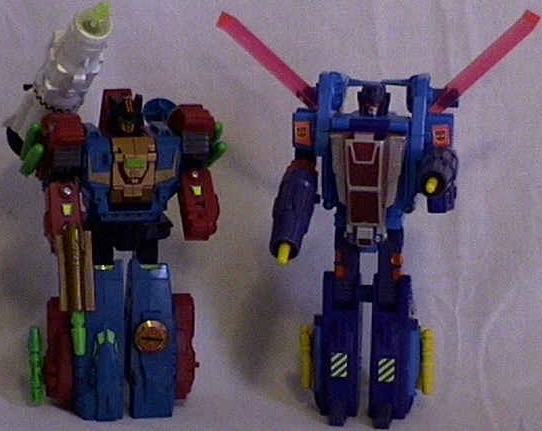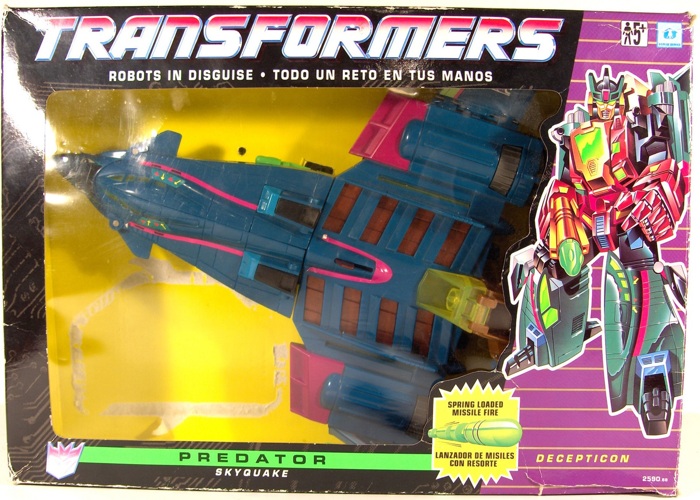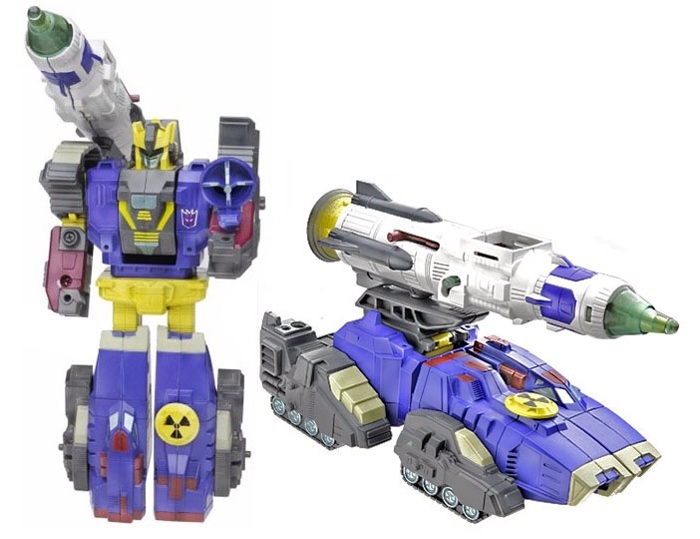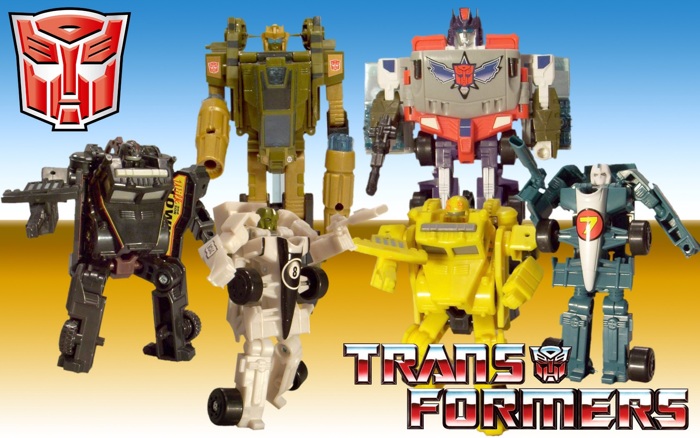The Also-Rans #1: Machine Wars Transformers
My first in a series of articles about the 'unsung heroes' of famous franchises.
Welcome to the first in a series of examinations of obscure iterations of some of our favorite pop culture franchises. These are mostly focused on the short-lived, little-known takes on series such as Transformers, G.I. Joe, He-Man, and cartoons based on the DC and Marvel universes, plus a few surprises. I'll be discussing when they came about, what their concept was, and why and when they faded from sight.
For today's inaugural subject, we focus on one of the most short-lived incarnations of the world's most famous robots in disguise: Machine Wars Transformers!

What It Is
The year was 1997. Hasbro/Kenner was in the second year of their successful relaunch of the Transformers toys, Beast Wars (which had spawned a hit animated cartoon series). Wanting to test the waters to see if vehicle-based Transformers could be a hit again, the toy giant teamed with closeout king KB Toys to reintroduce the Autobots and Decepticons in a brand new line. To avoid any costly pitfalls, all 12 toys in the series used molds of previously-released figures, four of whom never even made it beyond the prototype stage. Also being reused were a lot of classic names (and elements of some bios), box art from earlier lines, and the designs for the faction symbols from the 1992-95 'Generation 2' series.

Anchoring the basic size wave were 8 figures, with two each sharing the same mold. On the Autobot end were race cars Prowl and Mirage, and tow trucks Hoist and Hubcap; on the Decepticon side were all fighter jets, consisting of Dassault Rafael models Thundercracker and Skywarp, and Decepticon leader Megatron and his clone Megaplex, both F-22 Raptors. The four molds each were originally designed for Generation 2, but went unused once the line ended. All the figures featured two special gimmicks: a two-piece weapon they could store on their person, and a trigger-activated transformation, not unlike the basic figures from the 1996 wave of Beast Wars. Character-wise, only Hubcap differed from his original G1 self, while Megaplex was completely new. (Though there was a mix-up where the blue jet was labeled Megatron and the gray one Megaplex.)



The mega-size and ultra-size figures also used older molds, but for many collectors and consumers, it would be their first brush with Transformer molds that originated in Europe, from the time between the end of Generation 1 in 1990 and the start of Generation 2 in 1992. One distinct difference between the figures (aside from their colors) were the modified missile launchers, which had been effectively 'neutered' due to heightened child safety laws of the time.


The mega-size figures consisted of the Autobot Sandstorm, a repaint of the European Autobot Rotorstorm, and the Decepticon Soundwave, a repainted Euro-con named Stalker. (Rotorstorm, a decade or so later, would become a bit of a star in IDW Publishing's "Transformers: Last Stand of the Wreckers" miniseries.) Soundwave, in addition to losing his spring-loaded firing gimmick, also lost a key feature of his mold's originator. The larger Euro-cons had a gimmick where the smaller Predator jets could link with them--in this case, the rocket on Stalker--and when you flipped a scope, you would see a picture of an Autobot target. The picture in the rocket was removed, as the Predators never had a US release.




The ultra-size figures consisted of everyone's favorite scheming Decepticon Starscream, repainted from the Predator leader Skyquake; and venerable Autobot leader Optimus Prime, in his first figure without a mouth plate, due to his being a repaint of Turbomaster leader Thunderclash. Starscream also lost his scope gimmick in the 'translation' of the mold, but he still got what was then his biggest figure (until the release of his 2005 'Transformers: Cybertron' figure).
Why Short-Lived?
The Machine Wars series only lasted that one single wave of 12 robots. Why? The main reason, one for many toylines, is simple: without any tie-in media, be it a comic book or a TV series, little to no interest was generated in the line and sales were low as a result. Another contributing factor was the supposedly 'rushed' look and feel of the line as a whole, evidenced by the reused packaging art and figure molds. A third possible cause may have been fan overanticipation, based on this event (info courtesy of tfwiki.org):
"It has been speculated that Machine Wars would not have existed if not for a slip of the tongue at BotCon 1996. At the time, Beast Wars was in full effect, but Hasbro representative Anthony Gaud reportedly told a BotCon audience, in detail, that Hasbro was going to launch a Generation 1 revival as well, which naturally brought a LOT of excitement to the fandom. When the lackluster Machine Wars appeared the following year, with virtually none of the details mentioned coming to pass, some fans surmised that Hasbro had scrapped any true revival plans, but still felt the need to follow through on Gaud's remarks."
For today's inaugural subject, we focus on one of the most short-lived incarnations of the world's most famous robots in disguise: Machine Wars Transformers!

What It Is
The year was 1997. Hasbro/Kenner was in the second year of their successful relaunch of the Transformers toys, Beast Wars (which had spawned a hit animated cartoon series). Wanting to test the waters to see if vehicle-based Transformers could be a hit again, the toy giant teamed with closeout king KB Toys to reintroduce the Autobots and Decepticons in a brand new line. To avoid any costly pitfalls, all 12 toys in the series used molds of previously-released figures, four of whom never even made it beyond the prototype stage. Also being reused were a lot of classic names (and elements of some bios), box art from earlier lines, and the designs for the faction symbols from the 1992-95 'Generation 2' series.

Anchoring the basic size wave were 8 figures, with two each sharing the same mold. On the Autobot end were race cars Prowl and Mirage, and tow trucks Hoist and Hubcap; on the Decepticon side were all fighter jets, consisting of Dassault Rafael models Thundercracker and Skywarp, and Decepticon leader Megatron and his clone Megaplex, both F-22 Raptors. The four molds each were originally designed for Generation 2, but went unused once the line ended. All the figures featured two special gimmicks: a two-piece weapon they could store on their person, and a trigger-activated transformation, not unlike the basic figures from the 1996 wave of Beast Wars. Character-wise, only Hubcap differed from his original G1 self, while Megaplex was completely new. (Though there was a mix-up where the blue jet was labeled Megatron and the gray one Megaplex.)



The mega-size and ultra-size figures also used older molds, but for many collectors and consumers, it would be their first brush with Transformer molds that originated in Europe, from the time between the end of Generation 1 in 1990 and the start of Generation 2 in 1992. One distinct difference between the figures (aside from their colors) were the modified missile launchers, which had been effectively 'neutered' due to heightened child safety laws of the time.


The mega-size figures consisted of the Autobot Sandstorm, a repaint of the European Autobot Rotorstorm, and the Decepticon Soundwave, a repainted Euro-con named Stalker. (Rotorstorm, a decade or so later, would become a bit of a star in IDW Publishing's "Transformers: Last Stand of the Wreckers" miniseries.) Soundwave, in addition to losing his spring-loaded firing gimmick, also lost a key feature of his mold's originator. The larger Euro-cons had a gimmick where the smaller Predator jets could link with them--in this case, the rocket on Stalker--and when you flipped a scope, you would see a picture of an Autobot target. The picture in the rocket was removed, as the Predators never had a US release.




The ultra-size figures consisted of everyone's favorite scheming Decepticon Starscream, repainted from the Predator leader Skyquake; and venerable Autobot leader Optimus Prime, in his first figure without a mouth plate, due to his being a repaint of Turbomaster leader Thunderclash. Starscream also lost his scope gimmick in the 'translation' of the mold, but he still got what was then his biggest figure (until the release of his 2005 'Transformers: Cybertron' figure).
Why Short-Lived?
The Machine Wars series only lasted that one single wave of 12 robots. Why? The main reason, one for many toylines, is simple: without any tie-in media, be it a comic book or a TV series, little to no interest was generated in the line and sales were low as a result. Another contributing factor was the supposedly 'rushed' look and feel of the line as a whole, evidenced by the reused packaging art and figure molds. A third possible cause may have been fan overanticipation, based on this event (info courtesy of tfwiki.org):
"It has been speculated that Machine Wars would not have existed if not for a slip of the tongue at BotCon 1996. At the time, Beast Wars was in full effect, but Hasbro representative Anthony Gaud reportedly told a BotCon audience, in detail, that Hasbro was going to launch a Generation 1 revival as well, which naturally brought a LOT of excitement to the fandom. When the lackluster Machine Wars appeared the following year, with virtually none of the details mentioned coming to pass, some fans surmised that Hasbro had scrapped any true revival plans, but still felt the need to follow through on Gaud's remarks."
Either way, the line didn't sell well, and most of the unsold stock soon turned up at other retailers. BUT, Machine Wars did leave a legacy behind, one that continued to serve the Transformers brand--viable molds for later use. A LOT of use, in the following future Transformers lines:
1. The basic size jet molds would get used in 1998 for two characters from the Japan-exclusive Beast Wars II toyline and anime, the Predacons Thrust and Dirge (who ironically also used G1 character names).


2. All four basic size molds turned up in the 2001-02 Robots in Disguise series, as the Autobots Skid-Z and Tow-Line and the Decepticons Wind Sheer and Skyfire. Skid-Z and Tow-Line were lucky to be given roles in the accompanying cartoon series.




3. Sandstorm/Rotorstorm, Soundwave/Stalker, and Starscream/Skyquake all got repainted for the 2003-06 subline 'Transformers: Universe', as Whirl, Soundwave, and King Atlas (a homage to Japan-exclusive character Dai Atlas), respectively.



The Optimus Prime/Thunderclash mold was also to have gotten the Universe treatment, as an alternate version of G1 Menasor, but the plans were scrapped. A paint guide and prototype are all that exist of it.


4. The four basic molds were repainted for 2004-05's Japan-exclusive 'Robot Masters' series, as the Autobot Ligier (based on G1 Mirage), and the Decepticons Wrecker Hook, Air Hunter, and Wingstun.

5. The Transformers Collectors Club, for its 2006 Botcon figure set 'Dawn of Futures Past', dusted off the Thundercracker/Skywarp mold and used it for a pre-Beast Wars version of Predacon punchline Waspinator.

In 2013, the theme for the Botcon-exclusive figures was Machine Wars, and among the figures were new takes on the MW versions of Megaplex, Starscream, Thundercracker, Skywarp, Sandstorm, Hoist, and Mirage, all using more recent figure molds.

My own personal experience with the Machine Wars figures was lucking into them during three visits to two KB Toys locations on three different occasions. The only figures I ever got were Megatron (whose transformation made me think of the Robotech reruns airing on TV at the time), Prowl, and Soundwave, all three of whom ended up in boxes in storage for quite some time. Since then, I managed to recover Megatron and Prowl, buy myself a new copy of Prowl, and still have yet to find and recover Soundwave (along with Megatron's gun halves). I also found a Hubcap (sans grille and gun) at my local flea market. I personally think that these figures are underrated, with interesting designs and (in the case of the basic figures) a good amount of poseability. Boxed samples fetch a pretty penny these days, so if you ever see a Machine Wars figure for a good deal, I say go for it. These 12 figures are a good example of Hasbro's first attempt at a nostalgia-based line, and one that really could have been fleshed out if given more opportunity.


1. The basic size jet molds would get used in 1998 for two characters from the Japan-exclusive Beast Wars II toyline and anime, the Predacons Thrust and Dirge (who ironically also used G1 character names).


2. All four basic size molds turned up in the 2001-02 Robots in Disguise series, as the Autobots Skid-Z and Tow-Line and the Decepticons Wind Sheer and Skyfire. Skid-Z and Tow-Line were lucky to be given roles in the accompanying cartoon series.




3. Sandstorm/Rotorstorm, Soundwave/Stalker, and Starscream/Skyquake all got repainted for the 2003-06 subline 'Transformers: Universe', as Whirl, Soundwave, and King Atlas (a homage to Japan-exclusive character Dai Atlas), respectively.



The Optimus Prime/Thunderclash mold was also to have gotten the Universe treatment, as an alternate version of G1 Menasor, but the plans were scrapped. A paint guide and prototype are all that exist of it.


4. The four basic molds were repainted for 2004-05's Japan-exclusive 'Robot Masters' series, as the Autobot Ligier (based on G1 Mirage), and the Decepticons Wrecker Hook, Air Hunter, and Wingstun.

5. The Transformers Collectors Club, for its 2006 Botcon figure set 'Dawn of Futures Past', dusted off the Thundercracker/Skywarp mold and used it for a pre-Beast Wars version of Predacon punchline Waspinator.

In 2013, the theme for the Botcon-exclusive figures was Machine Wars, and among the figures were new takes on the MW versions of Megaplex, Starscream, Thundercracker, Skywarp, Sandstorm, Hoist, and Mirage, all using more recent figure molds.

My own personal experience with the Machine Wars figures was lucking into them during three visits to two KB Toys locations on three different occasions. The only figures I ever got were Megatron (whose transformation made me think of the Robotech reruns airing on TV at the time), Prowl, and Soundwave, all three of whom ended up in boxes in storage for quite some time. Since then, I managed to recover Megatron and Prowl, buy myself a new copy of Prowl, and still have yet to find and recover Soundwave (along with Megatron's gun halves). I also found a Hubcap (sans grille and gun) at my local flea market. I personally think that these figures are underrated, with interesting designs and (in the case of the basic figures) a good amount of poseability. Boxed samples fetch a pretty penny these days, so if you ever see a Machine Wars figure for a good deal, I say go for it. These 12 figures are a good example of Hasbro's first attempt at a nostalgia-based line, and one that really could have been fleshed out if given more opportunity.


6
Login To Vote!
More Articles From Captain_Retrograde




Comments
8